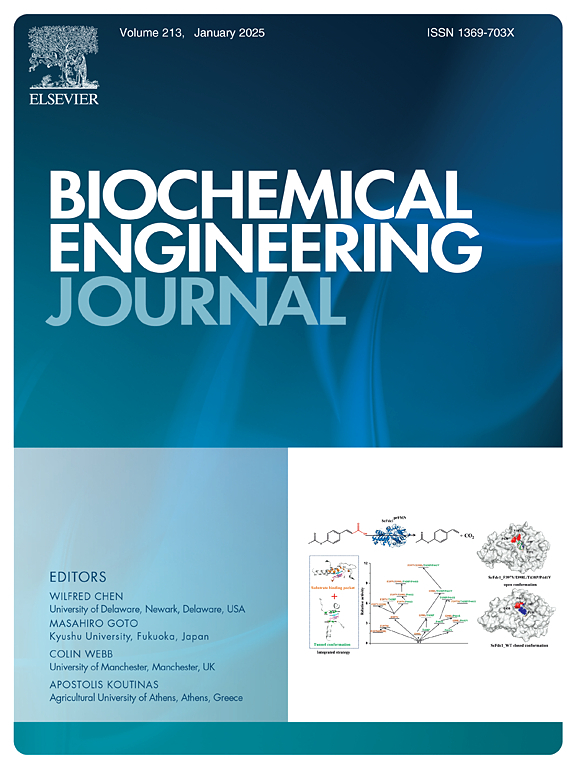高级氧化强化微生物电解池与厌氧消化相结合:煤气化废水处理的新方法
IF 3.7
3区 生物学
Q2 BIOTECHNOLOGY & APPLIED MICROBIOLOGY
引用次数: 0
摘要
煤气化废水(CGW)中含有一系列难降解的有毒有机污染物,生物降解性低,生物毒性大。本研究合成了一种用于过硫酸盐(PMS)活化的氨基石墨烯(H-graphene)催化剂。MEC-AD(微生物电解池-厌氧消化)反应器(K1)被指定为对照组。实验组为添加了 PMS 和 H-石墨烯的 MEC-AD 反应器(K2),以及添加了高级氧化作为合成 CGW 预处理的 MEC-AD 反应器(K3)。结果表明,K1、K2 和 K3 反应器的 COD 去除率分别为 76.7%、79.5% 和 87.4%,总酚去除率分别为 74.1%、90.1% 和 100%。在微生物电解池反应器 K2 和 K3 中,喹啉和吲哚的去除率超过 90%,在 K3 反应器中超过 100%。与 K1 反应器相比,K2 和 K3 反应器中未分类的 _ f _ Alcaligenaceae、Arenimonas 和未分类的 _ f _ Gracilibacteraceae 的数量大幅减少。负责促进长链脂肪酸厌氧降解和厌氧发酵产酸的未分类 _ p _ Zixibacteria、Candidatus _ Caldatribacterium、未分类 _ c _ JS1 和 JGI-0000079-D21 的数量有所增加。本文章由计算机程序翻译,如有差异,请以英文原文为准。
Advanced oxidation enhanced microbial electrolysis cell coupled with anaerobic digestion: A novel approach to coal gasification wastewater treatment
Coal gasification wastewater (CGW) contains a range of refractory and toxic organic pollutants with low biodegradability and significant biological toxicity. This study synthesized a hemin-graphene (H-graphene) catalyst for permonosulfate (PMS) activation. The MEC-AD (Microbial electrolysis cell- Anaerobic digestion) reactor (K1) was designated as the control group. The experimental groups were the MEC-AD reactor (K2) with PMS and H-graphene, and the MEC-AD reactor (K3) with advanced oxidation as a synthetic CGW pretreatment. The results demonstrated that the COD removal rates of K1, K2 and K3 reactors were 76.7 %, 79.5 % and 87.4 %, while the total phenol removal rates were 74.1 %, 90.1 % and 100 %, respectively. Quinoline and indole were removed at rates greater than 90 % in the microbial electrolytic cell reactors K2 and K3, and 100 % in the K3 reactor. In K2 and K3, there was a considerable decrease in the abundance of unclassified _ f _ Alcaligenaceae, Arenimonas and unclassified _ f _ Gracilibacteraceae as compared to K1. The abundance of unclassified _ p _ Zixibacteria, Candidatus _ Caldatribacterium, unclassified _ c _ JS1 and JGI-0000079-D21, which are responsible for promoting the anaerobic degradation of long-chain fatty acids and anaerobic fermentation of acid production increased.
求助全文
通过发布文献求助,成功后即可免费获取论文全文。
去求助
来源期刊

Biochemical Engineering Journal
工程技术-工程:化工
CiteScore
7.10
自引率
5.10%
发文量
380
审稿时长
34 days
期刊介绍:
The Biochemical Engineering Journal aims to promote progress in the crucial chemical engineering aspects of the development of biological processes associated with everything from raw materials preparation to product recovery relevant to industries as diverse as medical/healthcare, industrial biotechnology, and environmental biotechnology.
The Journal welcomes full length original research papers, short communications, and review papers* in the following research fields:
Biocatalysis (enzyme or microbial) and biotransformations, including immobilized biocatalyst preparation and kinetics
Biosensors and Biodevices including biofabrication and novel fuel cell development
Bioseparations including scale-up and protein refolding/renaturation
Environmental Bioengineering including bioconversion, bioremediation, and microbial fuel cells
Bioreactor Systems including characterization, optimization and scale-up
Bioresources and Biorefinery Engineering including biomass conversion, biofuels, bioenergy, and optimization
Industrial Biotechnology including specialty chemicals, platform chemicals and neutraceuticals
Biomaterials and Tissue Engineering including bioartificial organs, cell encapsulation, and controlled release
Cell Culture Engineering (plant, animal or insect cells) including viral vectors, monoclonal antibodies, recombinant proteins, vaccines, and secondary metabolites
Cell Therapies and Stem Cells including pluripotent, mesenchymal and hematopoietic stem cells; immunotherapies; tissue-specific differentiation; and cryopreservation
Metabolic Engineering, Systems and Synthetic Biology including OMICS, bioinformatics, in silico biology, and metabolic flux analysis
Protein Engineering including enzyme engineering and directed evolution.
 求助内容:
求助内容: 应助结果提醒方式:
应助结果提醒方式:


